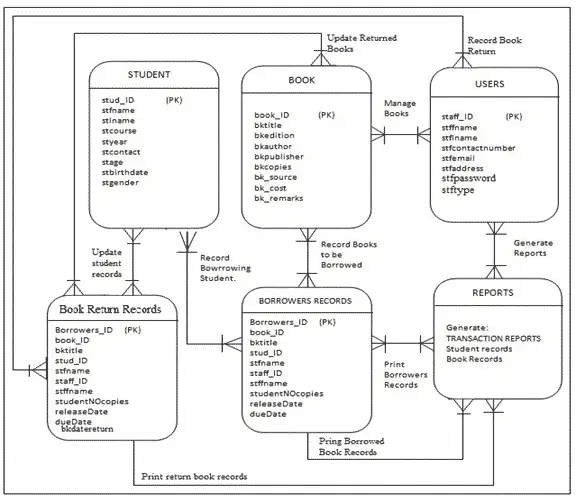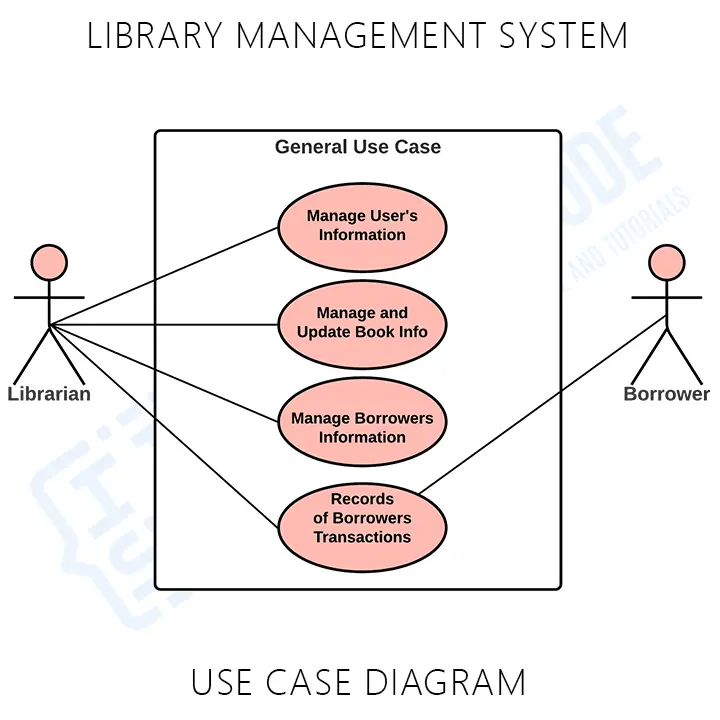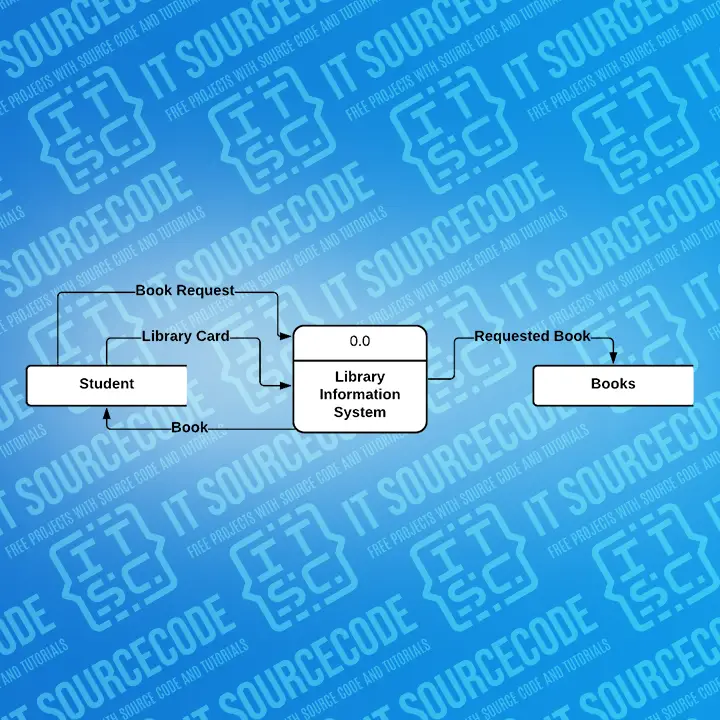ER Diagram For Library Management System Database Design
ER Diagram For Library Management System – This ER Diagram for Library Management System with table will give you an idea of how to make a database design for a library management system with ERD, tables, and schema.
The idea presented here can be used for your library management system final year project.
You can enhance the ER diagram for a library management system in this article to meet your personal system requirements.

What is included in this Library Management System Database project?
- Library Management System Description with Features
- Library management system database tables
- schema diagram for library management system
- ER Diagram for Library Management System
Library Management System Database Description
This library management system database was made based on school requirements.
The system can register book information. Librarian has easy access to each book, and search tabs for reliable, secure, and faster monitoring of books more importantly report and evaluation papers can be generated in well-organized and well-presented reports. (source)
ER Diagram For Library Management System With Tables : Features
Time needed: 5 minutes
Here’s the database design for the library management system with an ER diagram of the library management system including tables, schema, pdf, etc.
- Book Management
Book Management is the main feature of this er diagram for library management systems wherein it contains the basic details of books.
- User Management
This feature is only an add-on to ER diagram for the library management system it contains all the necessary information of the users.
- Manage Books Inventory
The Librarian can manage the books information such ISBN, Author, title, as well as the tracking of book history.
- Generate user-Friendly Reports
Can generate customized reports based on the client’s requirements.
- Student management system
This feature will store the student’s information’s such as student name, ID number, contact number address, etc.
ER Diagram For Library Management System Database Design (Tables)
These tables below provide the complete database tables details such as Field Name, Descriptions, data types, character lengths.
Table Name: tblbook
| Field Name | Description | Type | Length |
| book_ID | Book ID number | Int | 11 |
| bktitle | Book Title | varchar | 30 |
| bkedition | Book Edition | varchar | 30 |
| bkauthor | Author of the book | varchar | 30 |
| bkpublisher | Publisher of the book | varchar | 30 |
| bkcopies | Number of copies of the book | Int | 11 |
| bk_source | Source of the book | Varchar | 30 |
| bk_cost | Cost of the book | Int | 11 |
| bk_remarks | Status of the book | varchar | 30 |
Table Name: tblbtr
| Field Name | Description | Type | Length |
| Borrowers_id(PK) | Borrowers ID number | Int | 11 |
| Book_id | Book ID number | int | 11 |
| stud_ID | Student ID number | Int | 11 |
| staff_id | Staff ID number | Int | 11 |
| Staffname | Name of the staff | varchar | 30 |
| studentNOcopies | Number of books to be borrowed | int | 11 |
| ReleaseDate | Date of the publication that was release | Date | 30 |
| DueDate | Due date of the book to be returned | Date | 30 |
Table Name: tblreturn
| Field Name | Description | Type | Length |
| Borrowers_id(PK) | Borrowers ID number | Int | 11 |
| Book_id | Book ID number | int | 11 |
| stud_ID | Student ID number | Int | 11 |
| staff_id | Staff ID number | Int | 11 |
| Staffname | Name of the staff | varchar | 30 |
| studentNOcopies | Number of books to be borrowed | int | 11 |
| ReleaseDate | Date of the publication that was released | Date | 30 |
| DueDate | Due date of the book to be returned | Date | 30 |
Table Name: tblclearedrecords
| Field Name | Description | Type | Length |
| clearID(PK) | Specific ID for cleared records | Int | 11 |
| browID | Borrowers ID | Int | 11 |
| bookID | Book ID | Int | 11 |
| bookTitle | Book Title | Varchar | 30 |
| studID | Student ID | Int | 11 |
| studName | Student Name | Varchar | 30 |
| staffID | Staff ID | Int | 11 |
| staffName | Staff Name | Varchar | 30 |
| Studentcopies | Student number of book copies | Int | 11 |
| releaseDate | Date of release | Date | 11 |
| dueDate | Due date of the book | Date | 11 |
Table Name: tblreports
| Field Name | Description | Type | Length |
| rptID(PK) | Report ID | Int | 11 |
| rptTransaction_ID | Transaction ID | Int | 11 |
| rptbookID | Book ID | Int | 11 |
| Rptbktitle | Book Title | Varchar | 30 |
| Rptrtnbkcopiesreturn | Book Number of copies | Varchar | 30 |
| Rptrtndate | Date to be returned | Date | 11 |
| Rptremarks | Remarks of the Book | Varchar | 30 |
| Rptnumberofdays | Number of days to be borrowed | Int | 11 |
| Rptpenalty | A penalty of the student | Varchar | 30 |
| Rptreceive | Receive | Varchar | 30 |
Entity Relationship Diagram for Library Management System
ER Diagram of Library Management System shows the system entity relationships in each entity and their supposed functions in each relationship.
Sample ERD for Library system

Based on the image above, the ER diagram for Library Management System is the entity of the library management system database, which is presented by tables;
the tables are made to meet the required specification of the system and provide much more specific details of each entity within the system.
ER Diagram For Library Management System Database Design Bunos Knowledge
Sample ER Diagram for College Library Management System Project
This college library management system database design was made based on managing library requirements. The system can encode students’ or borrowers’ information.
College admin can have access to the students’ status and information for borrowing transactions. They can handle the data needed in managing books files as well as the transactions made by their borrowers.
The features included in the system ER diagram were the security and monitoring of the book and borrowers’ records, transactions, and status.
These features were also listed and recorded in reports that served as the history of transactions done in the system.
Sample ER Diagram for College Library Management System Project 
Click here to download the Library Management System PDF.
Library Management System Use Case Diagram UML
A use case diagram is a visual representation of how a user might interact with a program. A use case diagram depicts the system’s numerous use cases and different sorts of users and is frequently supplemented by other diagrams. Circles or ellipses are used to depict the use cases.
This discusses the meaning of the library management system project UML as well as its use case diagram using include and extend.
By creating the use case of the library management system, you must determine first the possible features to identify the flow of the system. After that, you can now create the blueprint or core of the system function.
Click here to download the Library Management System PDF.
Data Flow Diagram for Library Management System (DFD)
This knowledge will also give you deep understanding of Library management system DFD levels 0, 1, and 2. I will teach you also the terms in managing the Library transactions as well as the flow of activities that happens in the library management system.
The Data Flow Diagram (DFD) represents the flow of data and the transformations in the Library management system. These transformations occur as data enters and exits a system. In the DFD, input, processing, and output are used to represent and define the overall system.
Future Updates
For future updates of this material, I will make a tutorial on how to make an effective library management system project in DBMS.
Anyway, you can make better database design using online database design tools.
Conclusion
This is not yet a complete database project of a Library management system ERD. What you have in this material is for student use only.
FREE DOWNLOAD!
If you want to see the real application of er diagram library management system, Download here the Library Management System Full source code.
Downloadable source code using different programming Languages
- Online Library Management System in PHP Source Code
- Library Management System Project In Python and MySQL
- Library Management System Project in VB.Net With Source Code
- Library System in JavaScript with Source Code
- Library Management System In C++ With Source Code
- Library Management System In C With Source Code
- Library Management System Java Project With Source Code
- Library Management System Project In Django With Source Code
- School Library Management System in C# with Source Code
For another free material on database design.
- ER Diagram for Sales and Inventory System Database Design
- Ordering System Database Design with ERD
- ER Diagram for Water Refilling Station System Database Design
Inquiries
If you have any questions or suggestions about this library management system ERD, please feel free to contact us or you can leave a message below.


I dont know anything about the transction part
Can you explain to me or tell me how this works and how to write transactions
My regards